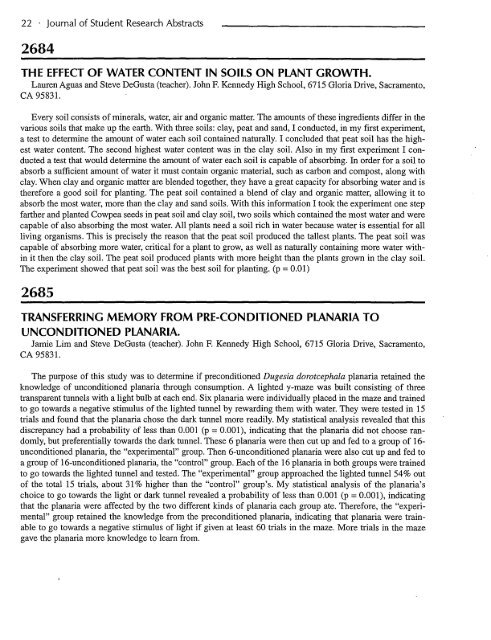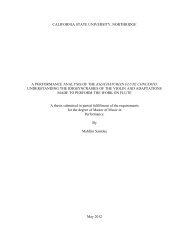2644 - CSUN ScholarWorks - California State University, Northridge
2644 - CSUN ScholarWorks - California State University, Northridge
2644 - CSUN ScholarWorks - California State University, Northridge
You also want an ePaper? Increase the reach of your titles
YUMPU automatically turns print PDFs into web optimized ePapers that Google loves.
22 · Journal of Student Research Abstracts<br />
2684<br />
THE EFFECT OF WATER CONTENT IN SOILS ON PLANT GROWTH.<br />
Lauren Aguas and Steve DeGusta (teacher). John F. Kennedy High School, 6715 Gloria Drive, Sacramento,<br />
CA 95831.<br />
Every soil consists of minerals, water, air and organic matter. The amounts of these ingredients differ in the<br />
various soils that make up the earth. With three soils: clay, peat and sand, I conducted, in my first experiment,<br />
a test to determine the amount of water each soil contained naturally. I concluded that peat soil has the highest<br />
water content. The second highest water content was in the clay soil. Also in my first experiment I conducted<br />
a test that would determine the amount of water each soil is capable of absorbing. In order for a soil to<br />
absorb a sufficient ainount of water it must contain organic material, such as carbon and compost, along with<br />
clay. When clay and organic matter are blended together, they have a great capacity for absorbing water and is<br />
therefore a good soil for planting. The peat soil contained a blend of clay and organic matter, allowing it to<br />
absorb the most water, more than the clay and sand soils. With this information I took the experiment one step<br />
farther and planted Cowpea seeds in peat soil and clay soil, two soils which contained the most water and were<br />
capable of also absorbing the most water. All plants need a soil rich in water because water is essential for all<br />
living organisms. This is precisely the reason that the peat soil produced the tallest plants. The peat soil was<br />
capable of absorbing more water, critical for a plant to grow, as well as naturally containing more water within<br />
it then the clay soil. The peat soil produced plants with more height than the plants grown in the clay soil.<br />
The experiment showed that peat soil was the best soil for planting. (p = 0.01)<br />
2685<br />
TRANSFERRING MEMORY FROM PRE-CONDITIONED PLANARIA TO<br />
UNCONDITIONED PLANARIA.<br />
Jamie Lim and Steve DeGusta (teacher). John F. Kennedy High School, 6715 Gloria Drive, Sacramento,<br />
CA 95831.<br />
The purpose of this study was to determine if preconditioned Dugesia dorotcephala planaria retained the<br />
knowledge of unconditioned planada through consumption. A lighted y-maze was built consisting of three<br />
transparent tunnels with a light bulb at each end. Six planada were individually placed in the maze and trained<br />
to go towards a negative stimulus of the lighted tunnel by rewarding them with water. They were tested in 15<br />
trials and found that the planada chose the dark tunnel more readily. My statistical analysis revealed that this<br />
discrepancy had a probability of less than 0.001 (p = 0.001), indicating that the planaria did not choose randomly,<br />
but preferentially towards the dark tunnel. These 6 planaria were then cut up and fed to a group of 16unconditioned<br />
planaria, the "experimental" group. Then 6-unconditioned planaria were also cut up and fed to<br />
a group of 16-unconditioned planaria, the "control" group. Each of the 16 planaria in both groups were trained<br />
to go towards the lighted tunnel and tested. The "experimental" group approached the lighted tunnel 54% out<br />
of the total 15 trials, about 31% higher than the "control" group's. My statistical analysis of the planaria's<br />
choice to go towards the light or dark tunnel revealed a probability of less than 0.001 (p = 0.001), indicating<br />
that the planaria were affected by the two different kinds of planaria each group ate. Therefore, the "experimental"<br />
group retained the knowledge from the preconditioned planaria, indicating that planada were trainable<br />
to go towards a negative stimulus of light if given at least 60 trials in the maze. More trials in the maze<br />
gave the planaria more knowledge to learn from.













